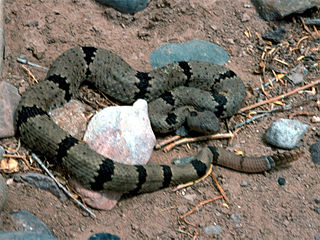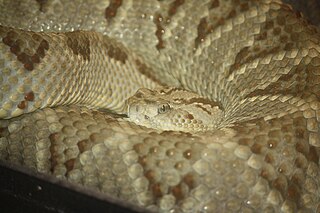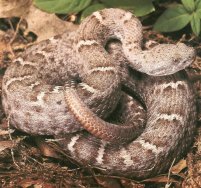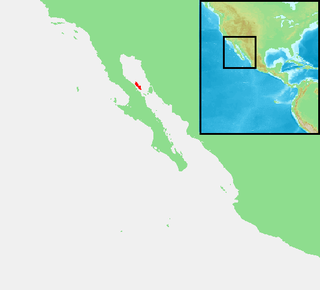
Crotalus helleri or Crotalus oreganus helleri, also known commonly as the Southern Pacific rattlesnake, the black diamond rattlesnake, and by several other common names, is a pit viper species or subspecies found in southwestern California and south into Baja California, Mexico, that is known for its regional variety of dangerous venom types. It is sometimes considered a subspecies of Crotalus oreganus.

Crotalus willardi is a venomous pit viper species found in the southwestern United States and Mexico. This snake is found mainly in the "sky island" region. The IUCN reports this snake's conservation status as being of Least Concern. It is the official state reptile of Arizona.

Crotalus ruber is a venomous pit viper species found in southwestern California in the United States and Baja California in Mexico. Three subspecies are currently recognized, including the nominate subspecies described here.

Crotalus mitchellii is a venomous pit viper species in the family Viperidae. The species is endemic to the Southwestern United States and adjacent northern Mexico. The species was named in honor of Silas Weir Mitchell (1829–1914), an American medical doctor who also studied rattlesnake venoms. Five subspecies are currently recognized, including the nominate subspecies described here.

Crotalus enyo, commonly known as the Baja California rattlesnake or Lower California rattlesnake, is a pit viper species native to the coast and islands of northwestern Mexico. Like all other pit vipers, it is venomous. Three subspecies are currently recognized, including the nominate subspecies described here.

Crotalus ravus, commonly known as the Mexican pigmy rattlesnake or Mexican pygmy rattlesnake, is a venomous pit viper species, found only in Mexico. Three subspecies are currently recognized.

Crotalus lepidus klauberi is a venomous pitviper subspecies endemic to the southwestern United States and adjacent northern Mexico.

Crotalus simus is a venomous pit viper species found in Mexico and Central America. The specific epithet is Latin for "flat-nosed", likely because its head is blunt compared with lanceheads (Bothrops). Three subspecies are recognized, including the nominate subspecies described here.

Crotalus oreganus, commonly known as the Western rattlesnake or northern Pacific rattlesnake, is a venomous pit viper species found in western North America from the Baja California Peninsula to the southern interior of British Columbia.

Crotalus atrox tortugensis is a venomous pit viper subspecies found only on Tortuga Island in the Gulf of California.

The Great Basin rattlesnake is a venomous pit viper species found in the Great Basin region of the United States.
Crotalus intermedius omiltemanus is a venomous pitviper subspecies found in Mexico in the state of Guerrero.

Crotalus cerastes cercobombus, commonly known as the Sonoran Desert sidewinder or Sonoran sidewinder, is a pitviper subspecies found in the eastern part of the Sonoran Desert in the southwestern United States and northwestern Mexico. Like all pitvipers, it is venomous. The subspecific epithet means buzzertail.
Crotalus cerastes laterorepens, with the common name Colorado Desert sidewinder, is a pitviper subspecies found in an area that centers on the Sonoran Colorado Desert in Southern California. It is also native to the Sonoran Desert in the Southwestern United States and Northwestern Mexico. Like all other pitvipers, it is venomous.

Crotalus willardi obscurus is a venomous pitviper subspecies found in northwestern Mexico and the Southwestern United States.
Crotalus totonacus is a venomous pit viper species found in northeastern Mexico. No subspecies are currently recognized.

Crotalus angelensis, or the Ángel de la Guarda Island speckled rattlesnake, is a pitviper species endemic to Isla Ángel de la Guarda in the Gulf of California, Mexico. Like all other pitvipers, it is venomous. It is sometimes treated as a subspecies of Crotalus mitchellii.

Crotalus oreganus caliginis is a venomous pit viper subspecies endemic to South Coronado Island, Mexico.
Crotalus lorenzoensis is a species of pit viper.
Crotalus mitchellii muertensis is a venomous pitviper subspecies endemic to El Muerto Island, Mexico. It is sometimes treated as a full species, Crotalus muertensis.














